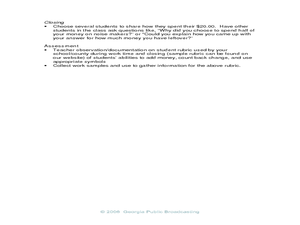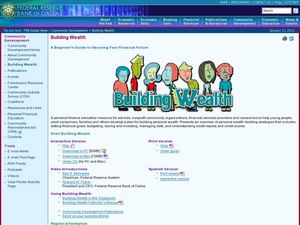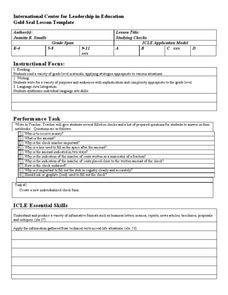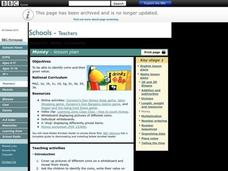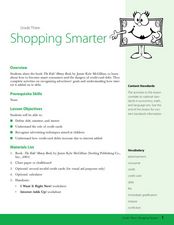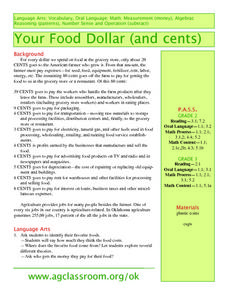Curated OER
Budgeting
Students explore what butgeting means. In this mathematics instructional activity, students determine that certain things need to be part of a budget like food and clothing by answering real-life types of questions on whether one should...
Curated OER
Estimation
Third graders practice using money. For this estimation lesson, 3rd graders show their ability to figure out the cost of lunch. Students then set up a "store" and students choose the products and estmate the cost. Students visit websites...
Curated OER
Coin Motion
Learners recognize coins and their values and count coin groups. They play a game where when music is turned on they skip, hop, jog and when it is turned off, they go to a spot in the room marked with the same coin or value as is in...
Curated OER
Real-World Reasonableness
Fifth graders apply math to real-world situations. In this mathematics lesson plan, 5th graders are read the book, "Math Curse," which discusses ways in which math is used each day. Students then write a sequel to the book in groups,...
Curated OER
How do You Stack Up? Revisited
Students estimate the thickness of coins. In this stack up instructional activity, students stack pennies, nickels, dimes and quarters. They calculate and record the thickness of each coin. Students stack coins and estimate the height...
Curated OER
Touring Delmarva
Learners plan a trip. In this trip planning lesson, students use a map to find where they would like to visit with a pretend family of 4. They get a specific amount of money and time and need to decide where they will stay and what they...
Curated OER
Shopping for a Party
Second graders produce a budget for a party. In this money management activity, 2nd graders create a budget for an imaginary party they will have based on a $20.00 limit. Students observe a video clip in class discussing budgets.
Curated OER
Problem Solving
Fifth graders read and write equations. In this equation writing lesson, 5th graders use real life scenarios to write equations. Students use manipulatives, draw pictures and make tables to understand how to write equations. Students...
Curated OER
A Trip to Colonial Virginia
Students consider prices while planning a trip to Colonial Virginia. In this budgeting lesson, students construct an itinerary of events for a vacation. Students are responsible for working within the approved budget.
Curated OER
Making Change for $1 And Identifying Different Bills
In this making change for one dollar and identifying different bills worksheet, young scholars color the coins needed to make exactly $1.00 on six different lines. Students also examine how to utilize a chart to solve money problems.
Curated OER
Invest In Yourself
Students learn about budgeting, saving, dept, financial management, opportunity cost, and self-regulation. For this financial management lesson, students apply their knowledge of finance components and create their own web based plan...
Curated OER
Variations on a Human Face Lab
Ninth graders gain an application level understanding of probability, symmetry, and ratios and rates that exists in one's everyday environment relative to human genetics.
Curated OER
The Business of Interest
Students learn about finance and money management and use math to solve problems, communicate, and explore real life situations as they deal with banks. In this financial management lesson, students apply their math skills to real life...
Curated OER
From the Mixed Up Files of Mrs. Basil E. Frankweiler
Students listen to From the Mixed-up Files of Mrs. Basil F. Frankweiler and discuss wants and needs. For this iincome and expenses lesson, students relate the adventures of the children in the book to a real life financial situation....
Curated OER
Building Wealth
Students explore budgeting. in this building wealth lesson, students examine ways to invest and save money. They set financial goals and determine methods to reach the goals. Students discuss managing debt, credit reports and credit...
Curated OER
Percents: What's the Use?
Learners explore percentages in real world situations. In this percents lesson, students determine the final sales price after discounts. Learners interview community members and determine how percentages are used in the real world.
Curated OER
Geometric Shape Cakes
Students become problem solvers and communicate geometrical ideas. In this geometrical shapes activity, students make a cake template from geometrical shapes.
Curated OER
Studying Checks
While on-line banking and electronic payments seem to be the way of the future, next-generation wage earners still need to understand the details of check writing. Here the focus is on the details of the check including what the...
Curated OER
Math Bargains
First graders use real coins or concrete models of coins to solve problems involving the purchase of items. They use cons and simulate going to a bargain store to purchase items. Students record the total cost of items. Pupils make a...
Curated OER
Money
Students complete online activities to identify coins and their given values. In this coin values lesson, students identify pictures of various coins and write their values. Students may then complete other activities based on a varying...
Curated OER
Combining Coins
Young scholars explore counting coins. In this money counting lesson, students are given an assigned number of coins and calculate the least amount of coins that could be used to equal the same value. Young scholars participate in guided...
Curated OER
Where Does All the Money Go?
Students explore the concept of uses for money. In this uses for money lesson, students discuss ways in which money can be utilized such as spending, saving, investing, donating, etc. Students discuss the differences between needs and...
Curated OER
Shopping Smarter
Students read a book about money and smart shopping to learn about debt, advertising, and the use of credit cards. In this consumer math lesson, students read the book The Kids' Money Book and discuss economic concepts. Students complete...
Curated OER
Your Food Dollar (and Cents)
Young scholars examine where their food dollars go while recognizing coins and making change. They identify their favorite foods, receive one dollar, and take away amounts for each person involved in the production of their food dollar.








